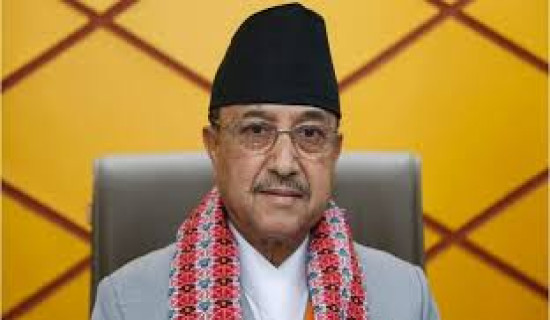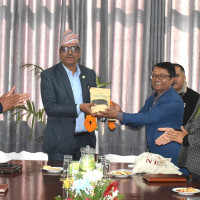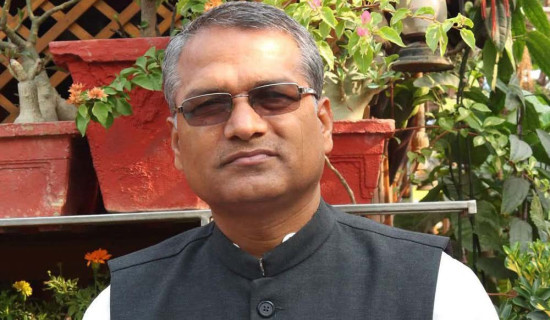- Saturday, 27 December 2025
Public transportation
No definite law, dedicated authority to manage vital service sector
By Nayak Paudel,Kathmandu, Feb. 19: "A normal bus used for 'public transport' costs millions. We don't get any subsidy or compensation. We are bound to pay heavy taxes annually under different heads. The roads we operate on are in poor state. How difficult do you think has it been for every public transport operator and investor to survive under these conditions?" questioned one of the investors of a fleet of buses operating along the 15-km-long Suryabinayak-Sundhara route.
Motor vehicles are the major mode of transport operating across Nepal followed by airways. Land transportation is also the cheapest and most convenient mode of transport in the country.
However, land transport operators argued that the sector could never improve under the present conditions where public transport has never been able to become a priority for any tier of the government.
"I bought a micro van by taking a loan and adding to it some money I saved while working in Malaysia for 10 years. It has been five years now, and I have neither been able to afford monthly installments nor support my family properly," said Shrawan, a microvan driver waiting for passengers in Sundhara early Saturday morning.
"After driving a public bus for 20 years, I had no savings. I couldn't even upgrade to a 2BHK flat from the 1BHK I have been living in for three decades. I then decided to buy a taxi. I took a loan. Now, after a decade, I see it was also a bad choice. Over three decades as a public vehicle driver, I came to know that we are not someone respected, treated, and facilitated as an individual working for the public," said Sanu Lal, a taxi driver searching for a parking space in New Road Saturday morning.
While operators stressed that they have been providing quality services under set rules and regulations, public transport users also argue that the sector was all but orderly.
“Every morning at 6, I reach my office in Putalisadak from Gothatar area. I have to wait for several buses only to find a vehicle where I can
thrust one of my feet, mostly door, and grab something. The situation is similar throughout the day due to lack of enough buses and the mismanagement thereof,” said Anjana Rai, a Korean-language instructor. Meanwhile, transport operators argued that they demanded for the reform of public transportation making the sector well-managed and
friendly with investors, workers, and passengers.
The transport organisations and associations also met with several concerned authorities within a month's time to draw their attention to public transport development.
“We submitted a memorandum to the Kathmandu Valley Traffic Police Office (KVTPO) on January 1, the Department of Transport Management (DoTM) on January 2, and the Ministry of Physical Infrastructure and Transport (MoPIT) on January 3,” read a joint statement by Nepal Yatayat Majdoor Sangh, Akhil Nepal Yatayat Majdoor Sangh and Nepal Yatayat Swatantra Majdoor Sangh.
The statement also informs that they had visited the Ministry of Home Affairs on January 20 with the memorandum. Since the requests were not addressed, the organisations submitted a 10-point demand at the MoPIT on January 31 informing that they were bound to take to the streets.
When transport operators gathered in Gongabu area last Monday in protest, it turned violent making the environment around the place tense throughout the afternoon and evening.
After the incident, a meeting chaired by Deputy Prime Minister (DPM) and Minister for Physical Infrastructure and Transport Narayan Kaji Shrestha met with agitated transport operators and assured to address their relevant demands.
“A high-level committee has been formed to study and discuss the demands put forth by transport operators. The committee will be submitting a report to the DPM soon after which necessary steps will be taken,” said Shiva Prasad Nepal, spokesperson for the MoPIT.
Lack of laws and roles
Since Nepal implemented federalism, transportation has been the jurisdiction of the respective provinces. Only vehicles operating in more than one province are overseen by the central DoTM.
“After federalism, the DoTM has been established as a coordinating body between transport authorities of all seven provinces. Now the provinces should improve their transportation facilities for themselves because it is the most effective and relevant thing to do,” said Ishwori Datta Paneru, information officer at the DoTM.
However, provincial governments argued that there were no concrete laws in the transportation sector due to a lack of a federal act. “Unless we have a federal act, provincial governments cannot create transport laws independently. Without laws, policies, and plans, no sector can develop further,” said Nepal, MoPIT spokesperson.
Meanwhile, Nepal informed that the ministry had drafted the federal act and was holding necessary discussions to finalise it and table it in the parliament at the earliest.
“We are also preparing a national transportation policy and a guideline for Kathmandu Valley Transport Authority Act. We will first improve our policies and then our actions,” Nepal told The Rising Nepal.
Among the 10-point demands, transport operators have sought a dedicated authority for transportation, the establishment of a Road Safety Council, an advanced traffic management system, adequate parking facilities, and an upgrade to the country’s transport infrastructure, such as roads and traffic lights.
“The demands are relevant. We are discussing necessary steps to address them because they are beneficial for the entire country when implemented. The high-level committee shall recommend necessary steps,” said Paneru.
Transport operators have also demanded a reduction in traffic fines and the return of annulled driving licenses.
“We recommend DoTM to annul driving licenses after people flout traffic rules more than five times. Returning annulled licenses isn’t an appropriate and legal practice. We will continue intensifying surveillance and penalise violators to ensure safety on roads,” said Deputy Inspector General of Police (DIGP) Meera Chaudhary, chief of the KVTPO.
Following the protest, the KVTPO has also started fining violators under three steps. “We will fine Rs. 500 for the first time an individual breaks any traffic rules. The fine will be Rs. 1,000 for the second time and Rs. 1,500 for the third and beyond,” said DIGP Chaudhary.
Transport operators have also shown reservations against the joint drive of the KVTPO and the Department of Environment to fine Rs. 5,000 to Rs. 100,000 under pollution test.
“Fines are mandatory to make people follow the traffic rules. Unless there is a fine, people will not follow the rules. Moreover, the present condition shows that if the fine was decreased or traffic rules loosely implemented, the Valley would slip into chaos due to reckless driving,” said DIGP Chaudhary.
Traffic police officers also informed that it was an irony to see transport operators demanding a reduction in traffic fines as it showed they wanted to flout the traffic rules just like that.
Prioritizing public transportation
Kunjan Rajbhandari, a developer working for an IT company, is looking for a second-hand motorcycle as he is frustrated by the haywire public transportation of the Kathmandu Valley.
“I had wanted to buy a motorcycle for the last three years. Now, I am completely fed up, so I am buying a two-wheeler,” said Rajbhandari, who was inspecting second-hand motorcycles at a reconditioning shop in Madhyapur Thimi on Friday evening.
Kathmandu Valley has the highest number of public as well as private vehicles. “If public transportation was better, many people wouldn’t buy a private vehicle. The purpose of a private vehicle is to reach a destination within the expected time in a comfortable manner. If the trend continues, public transportation will continue to deteriorate and private vehicles would crowd the Valley,” DIGP Chaudhary said.
“If the high-level government officials also had to travel by means of public transport, they might have improved the sector. Government officials travel in luxurious vehicles, so general people’s problem is not a part of their concern,” said Shrawan, the microvan driver.
Nevertheless, some government officials with whom The Rising Nepal spoke also admitted that the government wasn’t able to invest in public transportation both inside and outside the Valley.
“The government provides some support to Sajha Yatayat. It is the only step government has taken to improve road transportation for the public. The investment is, however, limited to the Valley. My hometown is in western Nepal. I am also one of the individuals who struggle to travel by road,” said a concerned government secretary under the condition of anonymity.
However, officials stressed that steps were being taken gradually to improve the situation.
“We know public transportation should be convenient and accessible for all. It is one of the basic rights of the people. Proper coordination is required from all three tiers of the government. We are working towards this end,” said Nepal, MoPIT’s spokesperson.
Meanwhile, agitated transport operators said that they would wait for the high-level committee’s report before taking any further steps.

















